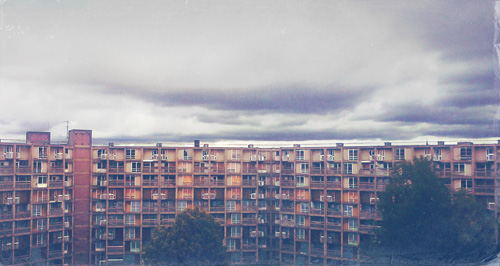
Guest blogger Matthew Mella goes on a walking tour exploring the Brutalist beauties of the Sheffield skyline as a new book imagines their future fates….
It’s a grey Friday morning in Sheffield as we cross train and tram tracks toward Park Hill, led by architecture writer and journalist Owen Hatherley. The tour is one of two organised to mark Site Gallery’s launch of Brutalist Speculations and Flights of Fancy, a book celebrating the concrete behemoths that redefined the city’s skyline after the Second World War.
I’ve heard the flats described as the first thing you see when you enter Sheffield due to their proximity to the train station. As they sit on the hill behind it, they are more likely to be the last thing you see as you leave – a goodbye wave from the city of the future. They are now split into three distinct parts. The portion that’s attracted the most recent attention is the first phase of redevelopment by Urban Splash. Stripped to the skeleton and refurnished with brightly coloured anodised panels and spiral steel staircases, the north block of Park Hill will soon become the epitome of twenty-first century city living. Tenants still occupy the south end of the sprawling estate, and between the new and the old is a no-man’s land of empty flats and iron doors.
Our guide’s acerbic wit is contrasted by an unabashed enthusiasm for the original architecture and the social vision behind it. Although short of utopian, the idealism and romance of these “streets in the sky” still rallies against the bad public image that the flats developed in recent decades – there’s a 1950s optimism baked into in the bricks and mosaic tiles. Hatherley raises questions of whether the dreams of modernist living failed or were simply defeated by new dogmas. I feel the only people who could confirm this are the local residents, but there’s no one to ask. At 11am, the still-populated “streets” are deserted except for a caretaker painting old railings like a version of Canute defying the wave of redevelopment. We continue the tour, speculating on the past and the future.
Park Hill is one of six buildings chosen as subjects for the book. The others include Moore Street Substation, Castle Market and the now-demolished Psalter Lane Art School. 25 artists and writers contribute, providing double page spreads that re-imagine, repurpose or reflect on these local landmarks. A dozen speak about their works at the symposium following the tours; Chloe Brown envisages the Oaks Water Tower in Gleadless as an archive of extinct animals; Penny McCarthy tells a science fiction story of abandoned space programs and broken dreams; Sharon Kivland remembers revolution at Psalter Lane. Nostalgia is a strong theme, with a deep sympathy for the idealist structures, their eroded purpose and their 21st century identity crises.
Writer Steve Pile describes the buildings as monuments, and describes Brutalism itself as a monument to the “lost ability to turn dreams into a concrete reality”. Park Hill may be Europe’s largest listed building, but other buildings are becoming endangered. With Psalter Lane Art School and other modernist landmarks from Sheffield now gone, these once indomitable hulks seem fragile and vulnerable.
Ironically, perhaps rescuing these buildings from redevelopment provides a monument to the optimism for change and the promise of a new way of living. Even if Corbusier’s visions didn’t quite translate to South Yorkshire, it’s nice to remember someone tried.
You can buy Brutalist Speculations and Flights of Fancy from Site Gallery’s shop.
You can learn more about Urban Splash’s plans for Park Hill here.